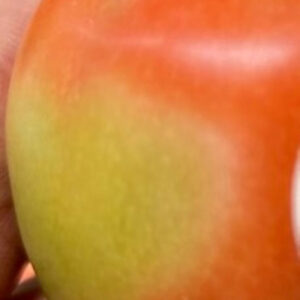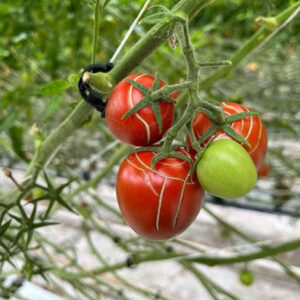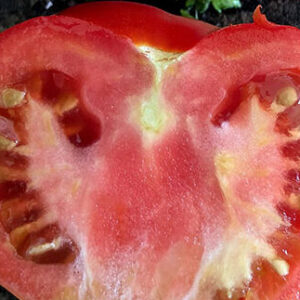
Features
Managing tomato crops under hot climate conditions
Guidance for growers working hard to get tomato crops through a long hot summer
June 29, 2023 By Dr. Mohyuddin Mirza
 FIGURE 1
FIGURE 1
Forest fires, windy and dry conditions and hot temperatures inside and outside the greenhouses has growers concerned about their tomato crops and of course other vegetables as well. The question is asked: what to do?
Here is a text message I received recently:
“The temperature inside my greenhouse is 30ºC plus. The relative humidity is below 50 per cent. The Vapor Pressure Deficit is consistently above 12 grams/m3 of air. The tomato plant heads have thinned out. The cluster set on this head is very weak. I also noticed blotchy ripening of some fruit which is more exposed to sunlight and mostly on the southside of the greenhouse. No Blossom End Rot seen yet. Did notice fruit surface cracking on a recently set cluster. Fruits are ripening faster as well. Few fruits are pointed at the end and turning red.”
Tomato plants produce three set of leaves and one cluster per week (as seen in Figure #1). The speed of this growth depends on temperature, carbon dioxide availability and other factors needed for photosynthesis. Under high day temperatures, like 30ºC, for few hours it becomes difficult to maintain a lower 24-hour average temperature around 18-19ºC. Photorespiration is also high and thus plant heads become more generative. Basically, the plant spends its food resources to keep itself cool through transpiration and not enough resources are allocated to growth of leaves, shoots and roots. In other words, assimilate partitioning is more towards plant maintenance rather than growth and development.
The clusters are also weaker, flowers are light yellow and bumble bees also don’t visit such weak flowers because of weak pollen production. Pollen viability is also significantly reduced.
What can be done?
- Wherever and whenever possible, for examples when nights are cooler, reduce the temperature to 16 to 17ºC. That will help to turn the plant to vegetative direction.
- Growers are advised to lower the plants before they reach the top wire. In this way, the plant heads may be in a micro climate zone of slightly lower temperature.
- Since high temperatures are directly related to light intensities, reduce the light infiltration by using screens.
- Use fogging systems to cool down the greenhouse.
- Apply roof shading wherever possible.
- Increase irrigation frequencies and start first irrigation earlier in relation to sunlight and last irrigation up to an hour before sunset.
- A night irrigation may be introduced if nights are warmer. I have seen some growers will use low nutrients EC of around 1.5 mS/cm for night irrigation.
- Poorly set clusters can be removed.
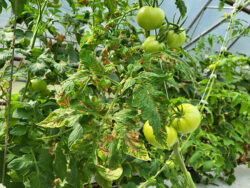
FIGURE 2
Dead spots on leaves, like in Figure #2, are due to constant exposure to temperatures over 30ºC and a VPD of over 12 grams/m3. Leaf temperature measurements by the author have recorded 42ºC when the air temperature was close to 35ºC. This is a very big stress on the leaves. Plant can selectively take up water and thus root zone EC can rise. Growers have reported EC values up to 6.6 mS/cm although feed EC values were much lower. It is recommended to introduce plain, pH adjusted water during very high-light periods. Many growers also supply cooler water during that time. A root zone temperature over 24ºC seriously affects the top growth and also necrosis seen on the leaves.
Blotchy ripening of fruit (Figure 3) is the result of heat stress on the fruit skin and can also be caused by potassium deficiency. Fruit surface temperature more exposed to direct sunlight may be very high and that area can bleach.
Cracks on the skin of the fruit (Figure 4) is triggered by warm surface temperature and notice the fruit is over ripened. Some cracks are deeper and seeds become visible. That is more due to water pressure of roots. This can be avoided by harvesting the fruit earlier and adjusting watering times in relation to root activity. For example, last watering should be around two hours before sunset.
Corky fruit flesh (Figure 5) is an indication of inadequate water available in the root zone at the time of high transpiration demand. This can also happen during high day temperatures when pollen viability is reduced and bumble bees are not working.
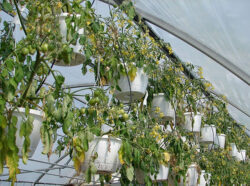
FIGURE 6
In the spring, tomato baskets are grown in large quantities and are exposed to high light and thus high temperatures. This can lead to wilting and high levels of EC (Figure 6) The plants can become very generative and blossom end rot can easily occur on the fruit.
To summarize, growers have to work hard to pull tomato crops through summer. Hopefully this guide can help to manage crops better.
Print this page
